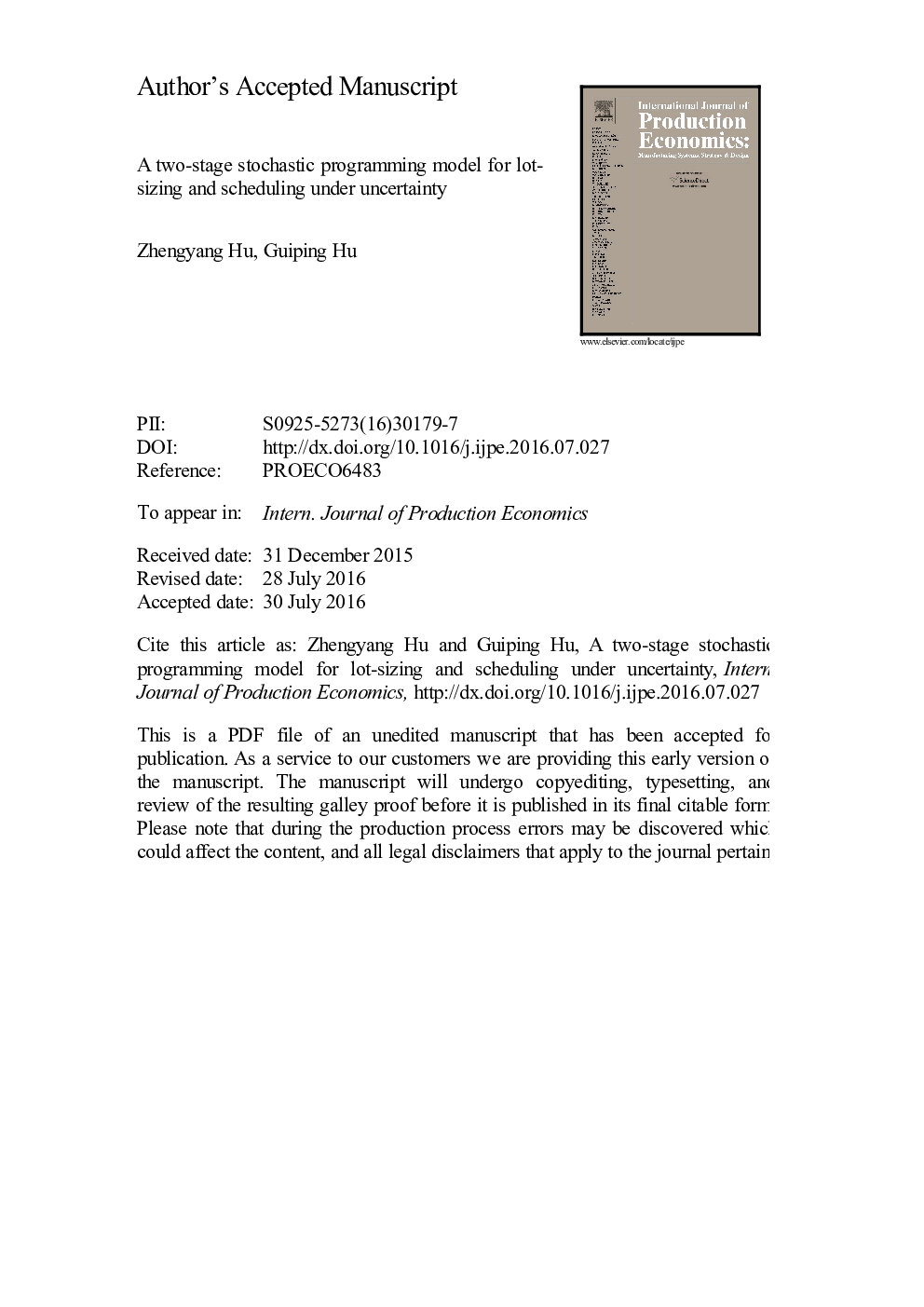| کد مقاله | کد نشریه | سال انتشار | مقاله انگلیسی | نسخه تمام متن |
|---|---|---|---|---|
| 5079199 | 1477527 | 2016 | 37 صفحه PDF | دانلود رایگان |
عنوان انگلیسی مقاله ISI
A two-stage stochastic programming model for lot-sizing and scheduling under uncertainty
ترجمه فارسی عنوان
یک مدل برنامه ریزی تصادفی دو مرحله ای برای اندازه گیری و برنامه ریزی در زمان عدم قطعیت
دانلود مقاله + سفارش ترجمه
دانلود مقاله ISI انگلیسی
رایگان برای ایرانیان
کلمات کلیدی
برنامه ریزی تصادفی، اندازه و برنامه ریزی طولانی، نسل سناریو، کاهش سناریو، صنعت خودرو،
ترجمه چکیده
در این مقاله مشکل بزرگی و برنامه ریزی با تنظیمات مربوط به دنباله در نظر گرفته شده است. در سیستم تولید، کارخانه ها مواد خام را از سایت های بالادستی دریافت می کنند و پس از تولید، محصولات نهایی به سایت های پایین دست و مشتریان منتقل می شود. کلید این است که برنامه ریزی تولید خوب را پیدا کنید تا هزینه آنها کم شود. یک مدل برنامه ریزی تصادفی دو مرحله ای برای به حداقل رساندن هزینه های کل تولید، موجودی و هزینه های پیشنهادی تشکیل شده است. مرحله اول تصمیم گیری تولید اولیه از جمله مقدار تولید هر محصول و دنباله ای از تولید را در حالی که مرحله دوم بر روی به روز رسانی احتمالی از تولید پایه مانند تولید بیش از حد تمرکز می کند. هدف این است که بهترین ترتیب مقادیر تولید را با توجه به تقاضای تصادفی با مجوزهای عقب افتاده پیدا کنید. عدم قطعیت به صراحت با یک درخت سناریو نمایش داده می شود و سپس انتخاب نماینده ترین سناریو ها برای به دست آوردن یک زیر مجموعه کوچکتر در حالی که حفظ خواص ضروری است. هر دو زمان راه اندازی و هزینه راه اندازی بستگی به محصول دارد. یک مطالعه مورد برای شرکت تولیدی تولید کننده تجهیزات ترمز به منظور نشان دادن و تایید مدل انجام شده است. نتایج نشان می دهد که مدل تصادفی بهتر از مدل قطعی است، به ویژه هنگامی که منابع تولید کافی وجود دارد.
موضوعات مرتبط
مهندسی و علوم پایه
سایر رشته های مهندسی
مهندسی صنعتی و تولید
چکیده انگلیسی
A lot-sizing and scheduling problem with sequence-dependent setups is addressed in this paper. In the production system, manufactories receive raw materials from upstream sites, and after production, the final products are shipped to downstream sites and customers. The key is to find a good production planning so that their cost is minimized. A two-stage stochastic programming model is formulated to minimize the total production, inventory and backorder costs. The first stage decides the baseline production including the production quantity of each product and the sequence of production while the second stage focuses on the possible updates of baseline production such as overtime production. The goal is to find the best sequence of production quantities under random demand with backorders allowed. Uncertainty is explicitly represented with a scenario tree then selecting the most representative scenarios in order to obtain a smaller subset while preserving essential properties. Both setup time and setup cost are product dependent. A case study for a manufacturing company producing braking equipment has been conducted to illustrate and validate the model. The results show that the stochastic model outperforms the deterministic model, especially when there are sufficient production resources.
ناشر
Database: Elsevier - ScienceDirect (ساینس دایرکت)
Journal: International Journal of Production Economics - Volume 180, October 2016, Pages 198-207
Journal: International Journal of Production Economics - Volume 180, October 2016, Pages 198-207
نویسندگان
Zhengyang Hu, Guiping Hu,
